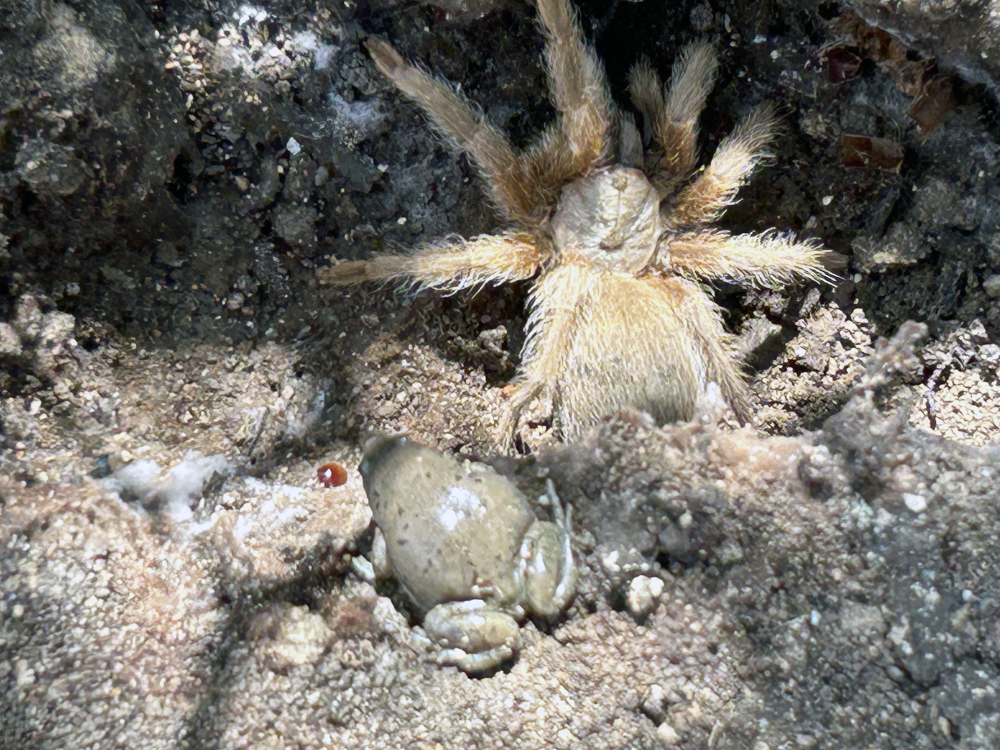A study that looked at how tarantulas interact with other animals has revealed that they are actually pretty chill with a wide range of species. The eight-legged critters that get some of us humans in such a twist were found living alongside amphibians, reptiles, whip spiders, and harvestmen across the globe. In some cases, the association may even be beneficial for both parties.
Tarantulas with friends? What a concept.
Spiders’ relationships with parasites and predators have been well-studied as a kind of antagonistic symbiosis, but there has been less research into whether spiders sometimes benefit from hanging out with other species. The new study decided to dive into the topic by reviewing published cases of tarantulas spotted with other animals, as well as exploring their possible defense strategies against problematic critters like ants.
You may have seen the odd viral post about how spiders like to keep “pets” based on observations of spiders and amphibians appearing to share a burrow. It’s been suggested it could be a kind of mutualism, where the frog or toad benefits from shelter and protection while it eats the problematic insects, ants, and parasites the tarantulas’ prey attracts, and which can be harmful to the spider and its offspring.
A Texas brown tarantula chilling with a Western narrow-mouthed toad.
Image credit: Alec Gaudiesus
The study’s findings indeed included many cases of amphibians chilling with tarantulas. However, it also showed for the first time that they interact with snakes, whip spiders, and harvestmen. Popular guys, these tarantulas.
Unrelated animals hanging out is a kind of symbiosis and it can be beneficial for both parties – or come at a cost for one. The exact symbiosis dynamics between tarantulas and the species observed in this study still require further investigation, but it goes to show we could have tarantulas all wrong.
“This study demonstrates that tarantulas are not ‘mindless killers’ as many might assume,” first author Dr Alireza Zamani told IFLScience. “Instead, they are capable of forming mutually beneficial relationships with unlikely partners, and these interactions are much more complex and common than we previously thought.”
The numerous spider interactions studied may also reveal the root cause (pun intended) of tarantulas’ characteristic hairiness, known to science as hirsuteness. Theraphosidae tarantulas are very hairy and have urticating hairs that develop with each molt that they can kick at attackers.
Tarantulas will hang from leaves when escaping killer ants.
Image credit: Emanuele Biggi
The authors put forward a new hypothesis that some hairs may be a defensive strategy against predatory ants – a foe that strikes enough fear in tarantulas that they’ll hang by one or two legs from a leaf, or even underwater using their hairiness to trap air. The hairs may also be protective in soft areas of the tarantula’s body that are most vulnerable to ant attacks as the stiff hairs make it harder for the ants to bite and hold on.
Additionally, the authors suggest that tarantulas may use a chemical defense strategy involving epidermal gland openings. This is based upon observations that cats and dogs sniffing tarantulas will wince and move away from them even when they aren’t kicking urticating hairs at them. Further research is needed to firm up the hypothesis, but the tarantulas’ antics with ants were a hit with the authors.
“My favorite interspecies interaction is perhaps the one between tarantulas and army ants,” said Zamani. “The dynamics of this relationship are not well understood, and their encounters are rarely documented despite being common. As we have proposed in our paper, it seems that this interaction plays a crucial role in the evolution of one of the most characteristic features of tarantulas: their hairiness.”
The authors hope that their findings open the door for further research into tarantula behavior, and the search for the evolutionary forces that drive interspecies interactions. Frankly, we’d love to see more research on the topic, and many, many more photos.
The study is published in the Journal of Natural History.
Source Link: Turns Out, Tarantulas Hang Out With Lots Of Animal Pals
